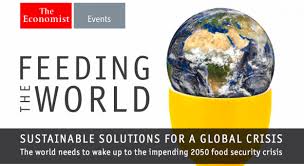“Without a proper food economy, you cannot have health. You cannot have education. You cannot have poverty reduction”. These comments from The Economist’s Deputy Editor Emma Duncan opened the 2014 Feeding the World Summit held in London last week, of which Farming First has now been a partner for three consecutive years. The day long discussion between policymakers, businesses, farmers and leading NGOs debated priority areas and solutions for the looming global challenge of feeding 9 billion people by 2050.
In his opening remarks, Paulus Verschuren, Special Envoy for Food and Nutrition Security of the Dutch Ministry of Foreign Affairs, outlined the challenge as “2-4-1”: two challenges (food AND nutrition security), four players (business, government, civil society and knowledge institutions) and one agenda (a united approach to solve hunger). “There is no shortage on global commitment,” he commented. “So what is holding us back?”
The level of commitment from the four players was praised by many of the speakers, in particular, that of governments. “Hunger and nutrition has been on the agenda of every global meet since 2008” commented Ertharin Cousin, Executive Director of the World Food Program. “As Norman Borlaug once said, commitment from governments (to food security) is as important, if not more important than the technology”. “Governments have finally woken up”, added the US State Department’s Jonathan Shrier; a point reinforced by UK Parliament’s Lynne Featherstone, who stated that the UK Department for International Development has doubled its resources for tackling undernutrition since 2008, investing in partnerships such as the CGIAR Consortium of international agricultural research centres.
Yet Kanayo Nwanze, President of the International Fund for Agricultural Development (IFAD) posed a provocative question. “When 40% of food never reaches the table, do we really need to produce more food?” Dr. Nwanze highlighted the issue of post harvest loss in developing countries, due to the lack of infrastructure that allows smallholder farmers to effectively store and transport their produce to market before it spoils. He commented that every developed economy was once rural, and that smallholder farmers must be supported to become more productive, through investment in roads and storage facilities as well as through improved access to energy and finance. Provided good governance structures and associations are put in place for smallholder farmers, Dr. Nwanze emphasised that the solutions lie with them.
In a dedicated panel discussion “An Action Plan for Smallholder Farmers”, the opportunity for investing in female farmers was made clear by the panel. Rose Akaki, a smallholder farmer from Uganda stated: “About 80% of farmers in Uganda are women, producing 60% of the food. But they only own around 1% of the land”. Lindiwe Majele Sibanda, CEO of Farming First Supporter FANRPAN noted that women choose to grow nutritionally dense crops to feed their children, as there is nothing more fulfilling for a mother than a healthy, thriving child. According to FAO, the nutrition and health improvements for children that a US$10 increase in women’s income would require a US$110 increase in male income.
Several businesses outlined the investments they have made in tackling the barriers to successful, sustainable farming in the developing world. Terje Morten Tollefse, Senior Vice President of fertilizer company Yara highlighted the Southern Agricultural Growth Corridor of Tanzania project, which is connecting farmers to markets and inputs. “Inputs don’t go all the way along the last mile to the smallholder,” he commented. “It makes sense for us to create a market that we can compete in and deliver the inputs – but we depend on the farmer becoming successful and being profitable therefore sustainable.”
Lindiwe Majele Sibanda however, highlighted the opportunity the private sector has not just to invest in the poorest farmers, but to help small, established agribusinesses grow. “(Private sector investment) will be more credible if people can see their own peers running big businesses, with access to credit and the ability to grow.” She commented that big business should not just stay big, but trickle down and lift up smaller businesses.
Opening the panel session “Tackling Malnutrition Now”, David Nabarro, the UN Special Representative on Food Security and Nutrition stated, “nutrition is a smart investment; in terms of economic benefits, school attendance and women’s empowerment.” Esin Mete, President of the International Fertilizer Industry Association explained the unexpected role that fertilizer can play in the fight against micronutrient deficiency and its related diseases. Fertilizers fortified with zinc in Turkey, she commented, led to the eradication of zinc deficiency in local populations, as they consumed the crops grown in nutrient-rich soils.
Sir Gordon Conway of Agriculture for Impact, speaking as part of the “Technology for Food Security” panel, set out a concept for sustainable intensification of agriculture that grows more food with fewer resources. The approach is threefold. The first, the agro-ecological approach, is based on the application of ecological principles and practices. Sir Gordon cited planting Faidherbia trees, which shed their leaves in the wet season, and provide a natural nutrient source to crops planted underneath as an example of this. The second, the genetic approach, applies the tools of modern cellular and molecular biology. For example, Orange Flesh Sweet Potato, bred to be rich in vitamin A, high-yielding and drought resistant, doubled vitamin A intake by women and children in 24,000 Ugandan and Mozambican households. The final approach, socio-economic, utilising social, economic and institutional interventions, for example, farmer associations. “Farmers need the power to bargain for better prices, to reduce waste. We need to find out which associations are sustainable in which place,” commented Sir Gordon.
Participants agreed that the solutions for feeding the world have already been identified; it is a case of acting on the multiple challenges with a unified approach. “This is a global challenge with a local solution requiring sustained public will across every level,” commented Ertharin Cousin of WFP. “There is no one size fits all solution, but a menu of solutions.”
For full and exclusive interviews featuring panel members, stay tuned on Farming First’s You Tube channel FarmingFirst.tv .



